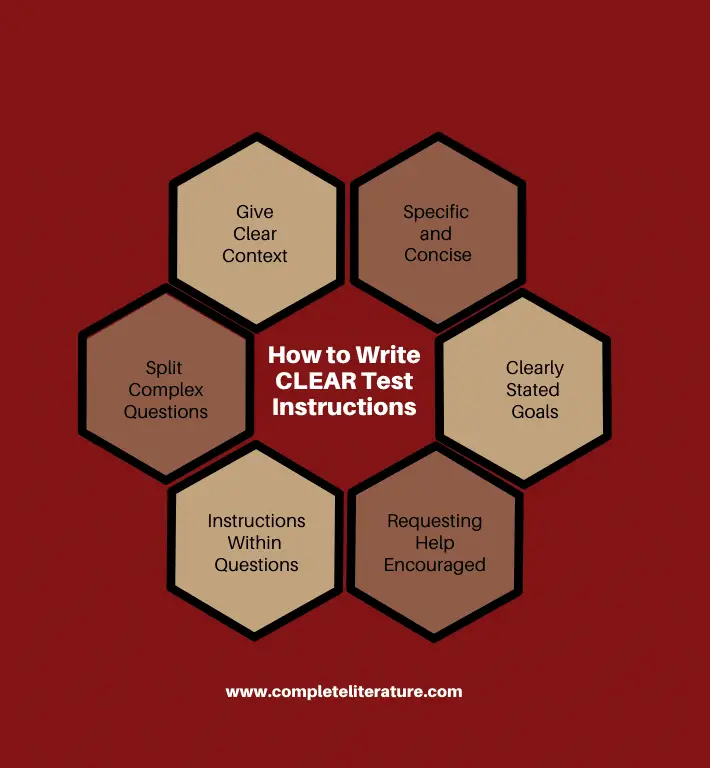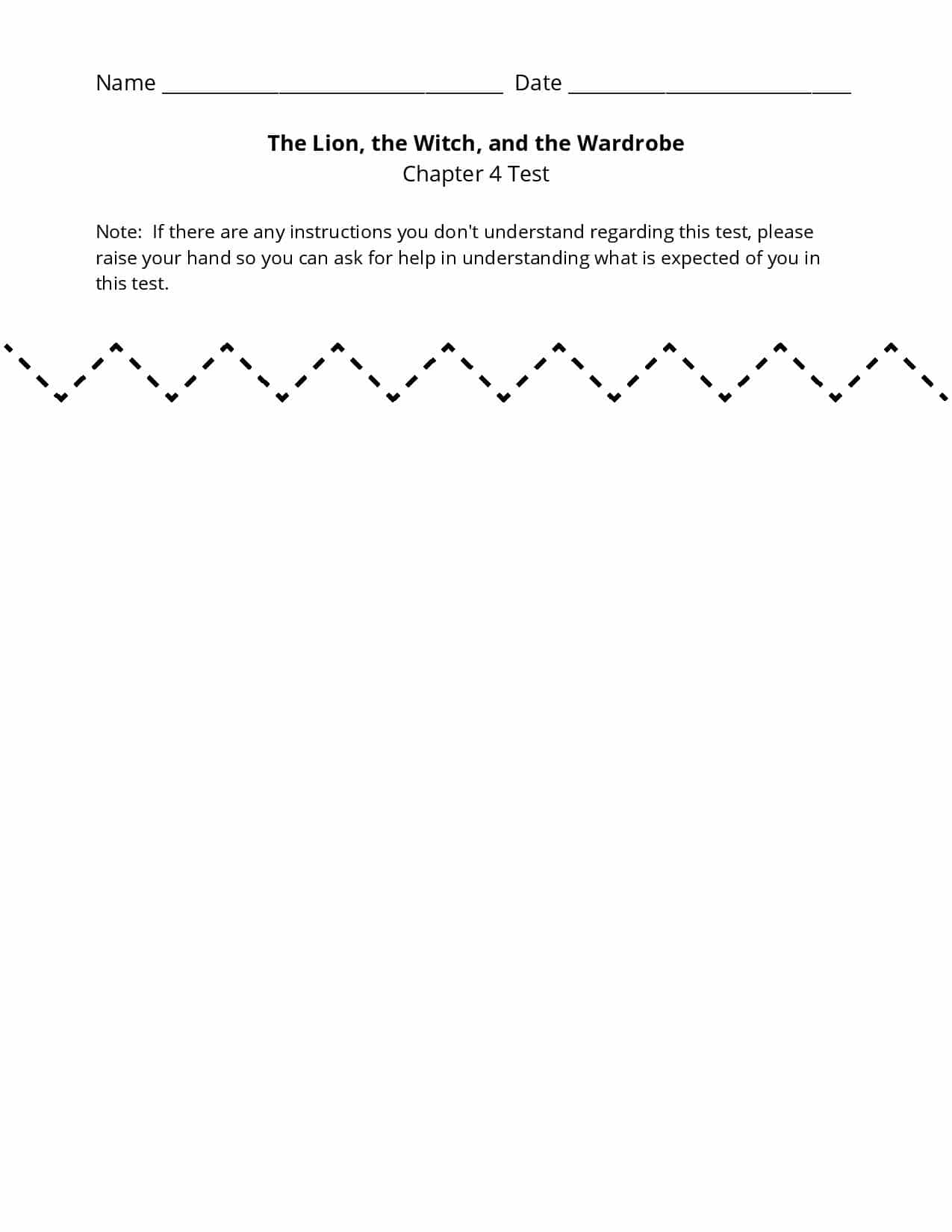Without writing clear instructions on a test, students cannot do their absolute best on that test, regardless of how much they have studied and mastered the material. But different people process information and instructions in different ways. So how do we write clear test instructions that everybody can understand, and then, in turn, perform well on the test that they are taking?
According to an article in Thoughtco, not following directions on a test is one of the top ten mistakes students make on tests. While not a cure-all, writing clear instructions on a test will help to prevent that from happening.
Over the years I have written many tests and honestly, thought little about how clear the instructions that I wrote were. My focus was generally on the test questions themselves.
While many test instructions, such as for true/false answers, are pretty straight forward, there are others that are not so cut and dry. And it was for those that I often realized after the fact that I had not communicated my instructions clearly enough for all of the students to adequately answer the questions.
So I did some research and looked into how I could better formulate clear instructions for my students’ tests. While there is little information online for this subject, I did find a wealth of information in other subject areas that directly pertain to writing clear instructions for school tests.
Table of Contents
Overview
Here are the 6 biggest factors I found helpful:
- Specifically state the exact information you are seeking from the student.
- Keep in mind what your goal answers were in asking those questions.
- Encourage students to get any needed help by stating directly on the test that if any parts of the instructions are unclear, the student should request help from the teacher.
- Consider writing the instructions on some of the questions in the questions themselves, rather than having a set of instructions for several following questions.
- Don’t let the instructions become complex. Keep them simple and specific. Split up complex questions as separate questions with spaces for answers in each step.
- Remember to give context.

Make Your Instructions Specific
One of the primary ways to write clear test instructions is to be specific and concise at the same time in your wording. Saying “answer the following questions” may work for some questions. But for others, you may need to be more specific.
If you are asking a question based on information your class learned that was extensive or covered a large amount of time, you will most likely need to point to a particular subset of that subject. This will help their minds to drill in on exactly the part of the concept/subject you are referring to.
In addition to this, adding irrelevant items to your test questions or instructions can actually distract your students and cause them to answer the questions incorrectly, or not the way you wanted them to answer it. Being very concise will help you to avoid this problem with your students.
Example
Note: For my examples, I will be using literature tests that I have issued in my studies on The Lion, the Witch, and the Wardrobe.
Here is an example of how to be specific and concise in writing clear test instructions:
Based on our classroom discussion on what tactics the White Witch used to trick Edmund into believing her, answer the following questions:
This allows the students to see exactly what part of the text you are testing them on without dragging them down with too many details or being so vague that they don’t know exactly what you are asking for.
Clearly State Your Goals in Your Instructions
I can’t tell you how many times I have been in a study group and the moderator/leader asks a question, but nobody knows exactly where he/she is going with the question or how to answer it.
Often we think that we are communicating our points clearly because we know everything that we are thinking. Others don’t know everything that is in our brain, so the knowledge they bring in reading those instructions could be comprehending something totally different than what we communicated.
There are a couple of great solutions to this. First, read back over your questions as though you are a student, trying to see it as they would. That can help you determine if you worded it well enough. Second, you can ask a fellow teacher to quickly read over it to make sure that it is cohesive in thought and written well enough for students to answer correctly.
Example
Here is an example of directly telling the students the goal that I have in the subsequent questions:
For the following questions, think about how Edmund responded to the White Witch after he enjoyed the Turkish Delight and hot drink. Then answer the questions in light of your notes and classroom discussion.
Provide a Note Encouraging Students to Seek Help for Instructions That Are Unclear to Them
Chances are you are not going to write perfect instructions on every test you write for your students over your whole teaching career. Actually, you are 100% guaranteed to not be perfect since we are all human.
One of the best ways we can solve this human error problem is to have a note on each test that reminds students to seek help if the test instructions are not clear to them.
This is a perfect solution because it allows you to dialog with the student until you are both confident that you are on the same page. And it also helps students to understand even if your instructions weren’t poorly written but student(s) are having a difficult time understanding.
Example
I am just going to show you an example from the top of a test form that I used:

Provide Instructions Within the Test Questions
This is especially effective when your test is comprised of single or multiple sentence answers or essay questions. By putting the instructions for what you are looking for in their answer within the question, you are allowing them fresh perspective on that particular question.
They don’t have to look back for it. And they won’t be confused because they have all of the tools they need for that question right there.
There are several advantages to this technique. First, they won’t lose their place and become more confused. Second, they will save time because they don’t have to flip back to another part of the test to make sure they are doing it correctly. And third, they will understand the instructions and the question better if it is all in the same place with no distractions.
Example
Here is an example of providing the instructions for answering the question within the question:
When you think about the White Witch trying to be nice to Edmund, but yet her evil tendencies emerge several times throughout her attempt to gain his trust, how do you think he was able to trust her without seeming to be affected by the evil that she couldn’t hide? __________________________________________________

Split Up Complex Test Instructions
If you have questions that need several steps to answer, the best way to do this is to split the sections up into digestible pieces for the students. This is more necessary in the younger grades. You wouldn’t necessarily need to do this for high school students.
If your question has multiple parts to it, go step by step and give your students room to answer the parts you have explained. This will allow them to see the progression of thought.
As they get older and tests no longer do this, they will still retain the knowledge of the thought process in multiple step test questions, even when those steps are no longer clearly separated. This is a great stepping stone to greater test taking. But it’s also a great way to get them to that place by showing them on paper what their brains will eventually do on its own.
Example
While this is more effective in more complex subjects such as math or science, it is also effective in literature. Here is an example:
How did the White Witch counsel Edmund with regard to the position of the 4 human children’s roles in Narnia? __________________________________________________
How did Aslan counsel Peter, Susan, and Lucy with regard to the position of the 4 human children’s roles in Narnia?__________________________________________________
How do you think the Pevensie children came together in fulfilling their roles in Narnia in spite of the very different counsel they received? __________________________________________________
Here are a couple of other articles about test taking in the classroom that may be helpful to you:
Should Teachers be Using True or False Questions on a Test?
Are Open Book Exams a Closed Case? The Pros and Cons
Remember to Give Context
I once took a test that would copy sentences from the text that I would need to fill in the blanks. The problem with that was that often the sentences had no context and I had no idea what section of study they were referring to. This was partially because the sentences were so general that I couldn’t tell the specific subject being covered. And it was also due to the same question being able to be asked across several subjects we had covered.
The problem with this was that the teacher was expecting a certain answer but there could have been multiple correct answers. And I couldn’t read his mind.
By giving a sentence of context leading up to the exact question, you are removing any confusion the student may have regarding what information you are looking for. They may not be able to recall the particular answer you are looking for, but at least there is no confusion on what you are talking about in your question.
Example
Here is an example of how context helps the students to recall specifically what I wanted them to regarding the questions that followed:
From our discussion on Chapter 4, where the White Witch spent the entire chapter tricking Edmund into trusting her so he would be willing to do anything she bade him, answer the following questions:
You can do this with each section that you are testing on. This allows the students to clearly understand what you are generally talking about. And it can even help them with recall when you are specifically addressing things that you covered in class.
Here’s a great bonus video that will help you to boost test scores in your classroom with one particular activity:
Conclusion
While these five tips and examples on how to write clear test instructions are a great start, I am sure that other teachers have come up with great tips as well in their own classroom experiences. I would love to hear more of them! Please feel free to comment your thoughts below.
If you enjoyed this article, I think you will also enjoy the following related articles:
How Many Questions Should be on a Test?
Seven Styles of Learning and How they Apply to Your Students
Best and Worst Reading Apps for Struggling Readers
Does Chewing Gum Help Students Focus?





I love that you included the little note about asking for help if the kids don’t understand a question. When I was a kid, I just had to muddle through the test whether I understood the questions or not.
I think that many teachers are willing to help in this way, but the students don’t realize it because the teachers never come out and say it. I think that teachers assume kids already know it, but they don’t always.
Oh my gosh I SO AGREE. I sometimes struggled with this but always just felt like if I didn’t understand that it probably just meant I hadn’t studied well enough, which is just so sad not that I look back on it.
Exactly, Krysten! I hope that this will help students and teachers going forward to close that communication gap.
This is such great info for teachers. I can remember a number of tests I had to take when I was in school that I was so lost because the instructions weren’t clear.
I remember the same, Heather. But it never even occurred to me to ask for help with the instructions. I just felt like I was on my own and needed to figure it out.
I have a friend who is also an educator and I am sure these things can help her to do a test/s for her students. I will definitely sharing this with her.
Thank you, Gervin!
These are great steps! I especially liked how you encourage the children to not be afraid to seek clarification if they need it as well as splitting up the complex questions. It can get so overwhelming for the students so these absolute help!
Thank you, Lucy!
This is really valuable information from a professional in their field. Thanks for your work.
These are such great instructions on writing clear test questions! The samples that you provided really help exemplify the instructions given, to make me feel confident that I could apply these tips in real life.
This is really helpful, thanks for including all the examples, this is simply brilliant.
These are awesome tips for writing clear test instructions. I remember being in school and getting frustrated when some instructions weren’t clear. It was obvious when more than one student would raise their hand to get clarifications on something, haha.
I wish that all instructors would read this so they know what is expected from the tests that they give out.
Any instructor needs to check out these tips and suggestions. Clear and precious.
YES! as a parent this is so perfect.
These are great tips on how to write test instructions so that people understand and comprehend what you are asking.
Very interesting info! I haven’t known that my teachers had to prepare so many things for a test, including this Test Instruction part.
This is very helpful for teachers while they are creating exams. It should be concise and straight to the point.
Great information for teachers! I’ll pass this on to my niece who is teaching grade-schoolers!
Having clear test instructions are very helpful because the students will be able to process the information and understand how to properly answer the questions without feeling as overwhelmed.
I just forwarded this to my 3 siblings who are all teachers. It’s very informative and helpful. I know that bad instructions increase your anxiety when you are writing your exam.
this is really helpful reading material for teachers. and such wonderful examples too.
this is fantastic. kid need clear instructions, my kids are a perfect example of that. anything complex and they don’t get it.
great information though..glad you shared these facts and ideas with us..they are truly very useful and helpful indeed…
This is great information for an educator. This is definitely back to school season
It might be useful to many around. Good details shared here.
This is so important and any test setter should read this, as with unclear information things can go down hill fast x
I absolutely adore this. I had a few classes when I was in school that I never tested well in, and it was because I didn’t fully understand the questions. The tests were always so confusing.
This is so informative! It’s very important to make sure you ask questions in a certain way so that students don’t misinterpret them!
These are all really helpful pointers! I think this is beneficial not just to teachers, but also to parents who will be teaching their children at home during the pandemic.
This is such a great resource for teachers, especially if they are new and haven’t had as much experience writing clear and concise test instructions. It was great that you added examples for each tip.
I found lectures without clear spots for taking notes are way worse in understanding and remembering.
These are such great tips! I hope that all educators, instructors and even home school parents get a chance to see these!
Kileen
cute & little
I love your comment about not being able to read the teacher’s mind. I remember tests in college where I felt frustrated by unclear instructions. All teachers should think this through carefully when building tests and follow your suggestions. Great article!
These are excellent tips! Thanks for sharing!
These are great tips and very helpful for new teachers. It’s really difficult to make test instructions and this will be very beneficial.
This is really great information for the teachers. Recently one of my friend started teaching so I am sharing with him hope this will definitely going to help him a lot
Glad you are making articles that would be really helpful, for educators. tha k you for sharing it.
Wonderful tips for teachers this year. Especially with most kids virtually learning clarity with definitely help with comprehension since many won’t get a face to face teacher.
Teaching is one of these amazing jobs that tests your ability to be flexible and inclusive when creating and presenting material, and then when assessing it – different people respond to things in different ways, so it’s super important to remember the varied audience when crafting test questions.